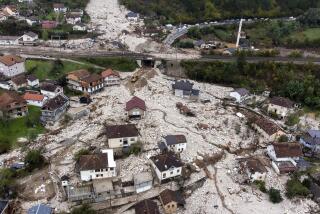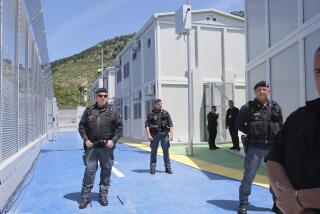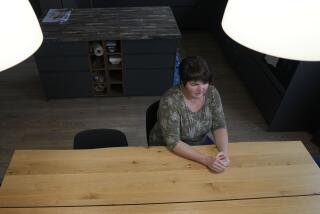Serbs’ Flight Is Latest Turn in Cycle of Hatred
BIJELJINA, Bosnia-Herzegovina — Milenko Dobrijevic stood among the defeated soldiers of the Krajina Serb army, now dejected members of a miserable mass of refugees, and vowed revenge Thursday.
“My grandfather was a Chetnik,” he said, referring to the Serbian royalists known for their brutality in both world wars. “He took his revenge, and I will do the same. The first Muslim or Croat I meet, even an innocent one, I will take his house.”
“And I,” proclaimed another of the soldiers, “will kill him.”
And so, as tens of thousands of Serb refugees made their way across the Balkans on tractors and in cars stuffed with meager belongings, the cycle of hatred and revenge that has fed four years of ruthless war turned again: Serbs who drove Croats from their homes were now being driven from their homes by Croats. One set of refugees replaced another, distinguishable only by its ethnic label.
On Thursday, thousands of bedraggled men, women, elderly and children reached Serbia, where overwhelmed authorities scrambled to settle them.
Many had been on the road for 20 hours or more, and they recounted harrowing stories of being stoned by large crowds of angry Croats as their convoys passed through the Croatian city of Sisak. At least two old women were killed and dozens of people injured while Croatian police, the refugees said, stood by.
The windows of scores of buses and cars were smashed; the refugees had pulled blankets and dish towels over the gaping holes to keep out the searing sun and driving rain that intermittently accompanied their journey.
From a number of vehicles, the Croats had ripped off the license plates, which in the former Yugoslav federation are a form of territorial identification because they bear the initials of the motorist’s hometown.
“We were guaranteed safe passage,” said Dejan Djuric, 18, his head wrapped in a bloodstained cloth. He escaped from his car as Croats wielding metal pipes overtook it, then he boarded one of the buses that crossed the Serbian border with Croatia on Thursday afternoon. “We would not have left if we had known this would happen.”
In the largest single exodus since the wars in the former Yugoslav republics began in 1991, lines of refugees stretched over hundreds of miles from Croatia to Serbia. Many of the Serbs were abandoning ancestral homes in the Krajina; in some cases, entire villages appeared to have emptied.
Many of the refugees arriving in Serbia, as well as those still stranded in Bosnia-Herzegovina, were bitter and felt betrayed--by their own commanders who ordered a hasty withdrawal, then vanished; by the Serbian government of President Slobodan Milosevic that did not send help.
*
In Bijeljina, a town in Serb-held Bosnia 12 miles west of the Drina River that divides Bosnia from the rump Yugoslavia made up of Serbia and Montenegro, the straggling Krajina soldiers described being overwhelmed by Croatian forces in the first hours of battle. They spoke with anguish, troubled at having to reconcile the image of the great Serb warrior with the new picture of an army suffering a rout.
“You are asking me why I didn’t stay in my village to continue fighting,” Dobrijevic, 27, said, casting his eyes downward. “It is impossible to fight when you are just one unit. We could only die or surrender. I did not want to fall into Ustasha hands.”
The Ustasha was the Nazis’ puppet regime that governed Croatia in World War II and was responsible for the murder of tens of thousands of Serbs and others. Many Serbs still refer to Croat leaders as Ustasha, just as many Croats and Muslims refer to Serb nationalists as Chetniks.
A dozen soldiers who were interviewed said they put up a fight when Croatia launched its offensive into the Krajina region last Friday but then quickly were ordered to withdraw by their commanders. Some, feeling abandoned and overpowered, fled in panic into nearby forests when the Croats unleashed their heavy artillery.
“This was treason, by our government, by our commanders,” Dobrijevic said. “They cheated the people.”
His escape convoy, carrying fighters and their families, was shelled by the Croats near the Krajina town of Petrovac as it withdrew, he said. At least eight people were killed, he said.
The soldiers said they were having to turn their weapons over to the Bosnian Serb army as they crossed through Serb-controlled portions of Bosnia but indicated they would not be fighting alongside the Bosnian Serbs, as has been feared.
The ordeal of the refugees flooding out of the Krajina is made more harsh by the uncertainty of not knowing what their immediate fates will be. Most have no idea of where they will end up. They are fearful of how they’ll be received by the Serbs of Yugoslavia, and the inflamed hatred that the refugees bring with them does not bode well for minorities there.
Serbian officials say they have permanent accommodations for about 20,000 refugees; as many as 200,000 are expected. Hoping to prevent the bulk of refugees from reaching the Serbian and Yugoslav capital of Belgrade, from which until now the war has been distant, the government is detouring most of them to 20 sites all over the country.
In a strategy likely to heighten ethnic tensions, the government plans to send at least 16,000 new arrivals to the remote southern province of Kosovo and 20,000 to the Vojvodina region north of Belgrade.
In Vojvodina, a traditionally tolerant and integrated region, the refugees will be expected to live alongside Croats; in Kosovo, the government may be hoping to settle the refugees as a counterweight against a growing community of Muslim Albanians who are at odds with Belgrade.
Refugee Nikola Sekovic stood outside the Yugoslav Red Cross in Belgrade on Thursday, waving his arms and railing at the prospect of being forced to settle in Kosovo. Long lists of names of registered refugees were posted on the Red Cross’ outer gates, as were notices seeking information on various families.
“They are sending us to Kosovo . . . a terrible hell,” Sekovic said, then employing a Serb pejorative for the people of Albania. “We don’t want to live with shiptar s [Albanians].”
Another refugee from the Krajina village of Dugo Selo, who would only give his first name, Jovan, was more circumspect. He said he was willing to go anywhere except a Krajina under Croatian control--even the bleak, Albanian-populated Kosovo. “It is better that I am slaughtered by someone I don’t know,” Jovan said, “than by my neighbor.”
*
En route to Serbia, many of the refugees passed through Bijeljina. This town too was “ethnically cleansed” of most of its Muslim population at the beginning of the war, then resettled with Bosnian Serb refugees.
Some of those earlier refugees watched quietly as caravans of the new refugees puttered by.
“We have been watching this for four days and it is very upsetting,” said Mirjana Maksimovic, a Bosnian Serb who fled the predominantly Muslim town of Tuzla. “There is a big fear among us that our destiny will be the same.”
The roads of Bijeljina were clogged with the endless procession of refugees. Townsfolk had posted hand-lettered signs to show the refugees the way to the border: “Serbia” said one sign, with an arrow pointing east.
More to Read
Sign up for Essential California
The most important California stories and recommendations in your inbox every morning.
You may occasionally receive promotional content from the Los Angeles Times.











